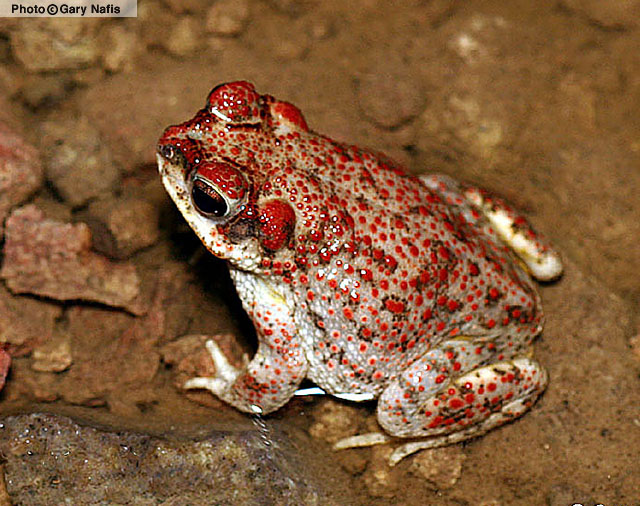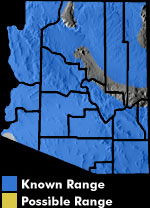Online Field Guide to The Reptiles and Amphibians of Arizona



Arizona
| RED-SPOTTED TOAD Anaxyrus punctatus | |
|
DESCRIPTION: Up to 3 inches in length, this small toad has a flattened head and body and round glands (parotoid glands) at the back of each side of the head that are about the same size as the eyes. Red-spotted toads lack prominent crests on the head. It is pale gray to tan above with small red or yellowish-red warts. Larger tadpoles are black or dark brown with metallic, bronze flecking. They grow to about 1.5 inches. DISTRIBUTION: Found at or near temporary or permanent water sources, often in rocky canyons or stream courses, from near sea level in southwestern Arizona into grasslands, Great Basin Desert, oak woodlands, and coniferous forests of central and southeastern Arizona, and the Colorado Plateau of northern Arizona. Absent from the highest montane areas and the Yuma Desert HABITAT: This is a toad of arroyos, desert streams, springs, tinajas, and cattle tanks, often in rocky areas, but can also be found on rivers and on the edges of agriculture. Occurs at or near permanent or temporary waters. Even in Arizona’s driest desert mountain ranges, this toad can be found breeding in rain-filled tinajas. BEHAVIOR: Red-spotted toads often spend the day in rock crevices or under rocks, and then emerge at dusk and walk to a nearby water source to forage or breed. They climb surprisingly well. Breeding males will engage in wrestling matches during territorial disputes. Red-spotted toads can tolerate a 40% loss in body water and still be active during dry periods. REPRODUCTION AND CALLS: Breeding occurs from March to September and is often stimulated by rainfall. Breeding of desert spring or stream populations typically occurs March-June, while populations breeding in temporary pools or tinajas breed June-September. The call is a high trill lasting 4-10 seconds made by males from the shallows of the breeding pond or nearby on land, in burrows, or under rocks. The eggs are deposited singly or sometimes in short strands on the bottom of a pool. Tadpoles metamorphose in1-2 months. DIET: Red-spotted toads eat a variety of arthropods, including ants, beetles, bees, and bugs. Large red-spotted toads have been observed eating recently metamorphosed toads. REMARKS: In Arizona, this species has hybridized with the Sonoran green toad, and the larger Woodhouse’s and Great Plains toads.
Degenhardt, W.G., C.W. Painter, and A.H. Price. 1996. Amphibians and Reptiles of New Mexico. University of New Mexico Press, Albuquerque. Grismer, L.L. 2002. Amphibians and Reptiles of Baja California, including its Pacific Islands and the Islands in the Sea of Cortez. University of California Press, Berkeley. Sullivan, B.K. 2005. Bufo punctatus Baird and Girard 1852(a) Red-spotted toad. Pages 430-432 in M.J. Lannoo (ed), Amphibian Declines: The Conservation Status of United States Species. University of California Press, Berkeley, CA. Sullivan, B.K., and P.J. Fernandez. 1999. Breeding activity, estimated age-structure, and growth in Sonoran Desert anurans. Herpetologica 55(3):334-343. |
|
Visit Partners in Amphibian and Reptile Conservation:


HOME
Copyright © 2023, Arizona Game and Fish Department. All rights reserved.
If you make use of the textual contents of this site in reports, publications, etc. please cite and credit the author(s) and photographer(s). All photos on this website are copyrighted. However, those found in the species account section may be used for any noncommercial scientific, educational, or conservation purposes provided that photographs are not altered and continue to bear the copyright symbol and name of the photographer. Please contact the photographer regarding commercial use of copyrighted photographs.










